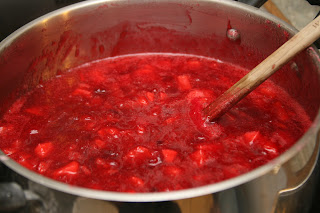We great apologize for our lack of presence the past few days. Busy weekend in the Ward household, but feeling truly blessed for a weekend full of friends, family and canning! There are a couple of recipes that we want to bring you, but, in the excitement of all of it, we totally forgot to take some prep pictures. For that, we apologize, but the recipes are delicious, nonetheless! Recipes are courtesy of tasteofhome.
Texas Jalapeno Jelly
The Goods:
- 2 jalapeno peppers, seeded and chopped
- 3 medium green peppers, cut into 1-inch pieces, divided
- 1-1/2 cups white vinegar, divided
- 6-1/2 cups sugar
- 1/2 to 1 teaspoon cayenne pepper
- 2 pouches (3 ounces each) liquid fruit pectin
- About 6 drops green food coloring, optional
- Cream cheese and crackers, optional
- In a blender or food processor, place the jalapenos, half of three Green peppers and 1/2 cup vinegar; cover and process until pureed. Transfer to a large dutch oven (sauce pan).
- Repeat with the remaining green peppers and another 1/2 cup vinegar.
- Add the sugar, cayenne and remaining vinegar to pan. Bring to a rolling boil over high heat, stirring constantly. Quickly stir in pectin. Return to a rolling boil; boil for one minute, stirring constantly.
- Remove from the heat; skim off foam. Add food coloring if desired. Carefully ladle hot mixture into hot half-pint jars, leaving 1/4-inch headspace. Remove air bubbles; wipe rims and adjust lids.
- Process for 10 minutes in a boiling-water canner. Serve over cream cheese with crackers if desired. Yield: 7 half-pints.
Tons o' flavor with just a hint of spice. If you aren't a pepper fan, there is still a great chance that you will love Texas twist on jelly. When serve as suggested (on top of crackers topped with cream cheese), there is a great balance of heat (I use that term lightly) and coolness. Plus, this is a great companion gift for the holidays with your Cranberry Apple Preserves.
Cinnamon Blueberry Jam
The Goods:
- 1 pound fresh or frozen blueberries (about 1 qt)
- 3-1/2 cups sugar
- 1 tablespoon bottled lemon juice
- 1/4 teaspoon ground cinnamon
- 1/8 group cloves
- 1 pouch (3 ounces) liquid fruit pectin
- Crush blueberries; measure 2-1/2 cups and place in a large saucepan.
- Add the sugar, lemon juice, cinnamon and cloves; bring to a rolling boil over high heat, stirring constantly. Quickly stir in the pectin. Return to a full rolling boil; boil for one minute, stirring constantly.
- Remove from the heat; skim off foam. Carefully ladle hot mixture into hot half-pint jars, leaving 1/4-inch headspace. Remove air bubbles; wipe rims and adjust lids. Process for 10 minutes in boiling water canner. Yield: 4 half-pints.
Not only pleasing to the eyes, this one is pleasing to the tummy, as well. On bread, crackers or an english muffin, this deep-purple jam offers not only the traditional fruitiness of a typical jam or jelly, but also the richness of the cinnamon and cloves that are included. You can literally dissect and analyze each of the unique flavors, but they coexist so wonderfully.
So, there you have it! A couple of jams and jellies that will make any commercial canned cranberry sauce jealous. While we're on the topic, what are your favorite canned goodies to gift during the holidays? Let us know in our comments section as we would love to hear from you! If you leave a recipe, you never know. You might just see your recipe featured on our next blog post!
Until then...
Keep Calm
and
Can On

















